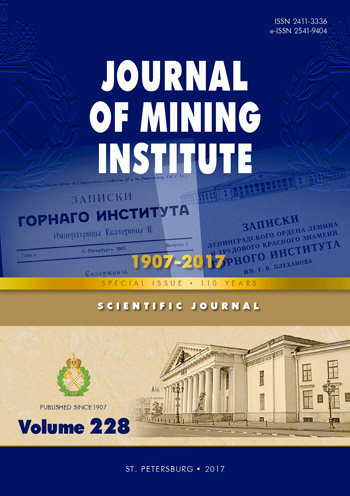Influence of a discrete additive of aluminum oxide on structure and properties of aluminum alloy
- 1 — Ph.D., Dr.Sci. professor Bauman Moscow State Technical University (National Research University)
- 2 — assistant lecturer Bauman Moscow State Technical University (National Research University)
Abstract
On the basis of the literature review, there were identified the problem and the relevance of the development of the technology for introducing additives of nano-sized fillers into aluminum alloys in order to determine the mechanism for controlling the structurally dependent properties. As such an additive, alumina fibers of 10-20 nm in diameter were selected. The introduction of the additive into the liquid alloy is implemented by means of mechanical mixing. Technological features of the process allowed to solve the problem of overcoming the forces of surface tension and distribution of additives, which are quantitatively small and light in comparison with the main material. Experimental samples were obtained under laboratory conditions using the specially designed equipment. To perform the comparative analysis, samples of the base alloy of the composition AK6 and filled with a discrete additive of 1 % alloy of the same composition were obtained in identical modes. Investigations of the structure and properties of the base alloy and samples obtained by mixing in the base alloy of thin discrete alumina fibers in a volume of 1 % were performed using standard metallographic analysis techniques and a hardness measurement method. As a result of macro- and microscopic studies, a modifying effect was found from the addition of finely dispersed Al2O3 to an aluminum alloy, which manifested as grain refinement. The shape of the hardness distribution curves obtained as a result of the processing of statistical data is identical for the compared samples and has a pronounced shifted extremum, which indicates changes in the properties on the one hand and demonstrates a sufficient level of assimilation of the additives by the liquid alloy, on the other. Consequently, the expediency of using the suggested method of modification for obtaining materials of this group is obvious.
References
- Kurganova Yu.A., Berezovskii V.V., Solyaev Yu.O., Lur'e S.A., Shavnev A.A. Investigation of mechanical properties of MKM based on an aluminum alloy reinforced with dispersed particles of silicon carbide. Deformatsiya i razrushenie materialov. 2014. N 12, р.12-16 (in Russian).
- Kalashnikov I.E. Development of methods for reinforcing and modifying the structure of aluminum-matrix composite materials: Avtoref. dis… d-ra tekhn. nauk. IMET im. A.A.Baikova RAN. Moscow, 2011, р. 40 (in Russian).
- Kurganova Yu.A., Kolmakov A.G. Structural metal matrix composites. Moscow: Izd-vo MGTU im. N.E.Baumana, 2015, р. 141 (in Russian).
- Kurganova Yu.A., Lopatina Yu.A. Analysis of the distribution of the reinforcing phase in alumo-matrix CM. Zagotovitel'nye proizvodstva v mashinostroenii. 2015. N 4, р. 42-48 (in Russian).
- Chernyshova T.A., Kurganova Yu.A., Kobeleva L.I., Bolotova L.K. Cast dispersion-hardened alumo-matrix composite materials: manufacturing, properties, application. UlGTU. Ul'yanovsk, 2012, р. 295 (in Russian).
- Sokolov G.N., Troshkov A.S., Lysak V.I. et al. Modification of the weld metal structure by nanodispersed tungsten carbides. Fizika i khimiya obrabotki materialov. 2009. N 6, р. 41-47 (in Russian).
- Serpova V.M., Shavnev A.A., Grishina O.I., Krasnov E.N., Solyaev Yu.O. Wetability and interfacial interaction in a metal composite material on an aluminum matrix reinforced with aluminum oxide. Materialovedenie. 2014. N 12, р. 29-35 (in Russian).
- Fetisov G.P., Kurganova Yu.A., Gavrilov G.N. Composite materials in aviation and their forecasting. Tekhnologiya metallov. 2015. N 1, р. 22-25 (in Russian).
- Zakaria M.R., Akil H.M., Kudus А.А., Saleh S.M. Enhancement of tensile and thermal properties of epoxy nanocomposites through chemical hybridization of carbon, nanotubes and alumina. Compos. A Appl. Sci. Manuf. 2014. N 66, р. 109-116.
- Berezovskiia V.V., Solyaevb Yu.O., Lur’eb S.A., Babaitsevc A.V., Shavneva A.A, Kurganova Yu.A. Mechanical Properties of a Metallic Composite Material Based on an Aluminum Alloy Reinforced by Dispersed Silicon Carbide Particles. Russian Metallurgy (Metally). 2015. N 10, p.790-794.
- Knowles A.J., Jiang X., Galano M. Audebert F.Microstructure and mechanical properties of 6061Al alloy based composites with SiC nanoparticles. J. Alloys Compd. 2014. N 615, р. 401-405.
- Kollo L., Radbury B.C., Veinthal R., Jäggi C., Carreño-Morelli, Leparoux M. Nanosilicon carbide reinforced aluminium produced by high-energy milling and hot consolidation. Mater. Sci. Eng. 2011. A 528 (21), р. 6606-6615.
- Meysam T.K., Fergusona J.B., Benjamin F.S., Kima C.S., Cho K., Rohatgi P.K. Strengthening mechanisms of graphene- and Al2O3 – reinforced aluminum nanocomposites synthesized by room temperature milling. Mater. Des. 2016. N 92, р. 79-87.
- Saha R., Morris E., Chawla N. Hybrid and conventional particle reinforced metal matrix composites by squeeze infiltration casting. J. Mater. Sci. Lett. 2002. N 21, р. 337-339.
- Jiang L., Yang H., Yee J.K., Mo X., Topping T., Lavernia E.J. Toughening of aluminum matrix nanocomposites via spatial arrays of boron carbide spherical nanoparticles. Acta Mater. 2016. N 103, р. 128-140.
- Tjong S.C. Recent progress in the development and properties of novel metal matrix nanocomposites reinforced with carbon nanotubes and graphene nanosheets. Mater. Sci. Eng. 2013. R74, р. 281-350.
